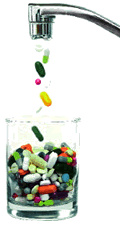
Thanks GSK, Pfizer etc.
Drinking tap water in America is unsafe. Associated Press has uncovered a massive scandal over pharmaceuticals in the nation’s drinking water.
“A vast array of pharmaceuticals — including antibiotics, anti-convulsants, mood stabilizers and sex hormones — have been found in the drinking water supplies of at least 41 million Americans,” AP found. In fact the figure is far higher – this is all they have been able to prove.
It is inconceivable that the world’s leading drug companies were unaware of the extent of the problem, which is caused by prescription drugs passing through the bodies of patients, then through sewage treatment plants. But these drugs are not filtered out.
To be sure, the concentrations of these pharmaceuticals are tiny, measured in quantities of parts per billion or trillion, far below the levels of a medical dose. Also, utilities insist their water is safe.
But the presence of so many prescription drugs — and over-the-counter medicines like acetaminophen and ibuprofen — in so much of our drinking water is heightening worries among scientists of long-term consequences to human health.
In the course of a five-month inquiry, the AP discovered that drugs have been detected in the drinking water supplies of 24 major metropolitan areas — from Southern California to Northern New Jersey, from Detroit to Louisville, Ky.
Water providers rarely disclose results of pharmaceutical screenings, unless pressed, the AP found. For example, the head of a group representing major California suppliers said the public ”doesn’t know how to interpret the information” and might be unduly alarmed.
How do the drugs get into the water?
People take pills. Their bodies absorb some of the medication, but the rest of it passes through and is flushed down the toilet. The wastewater is treated before it is discharged into reservoirs, rivers or lakes. Then, some of the water is cleansed again at drinking water treatment plants and piped to consumers. But most treatments do not remove all drug residue.
And while researchers do not yet understand the exact risks from decades of persistent exposure to random combinations of low levels of pharmaceuticals, recent studies — which have gone virtually unnoticed by the general public — have found alarming effects on human cells and wildlife.
”We recognize it is a growing concern and we’re taking it very seriously,” said Benjamin H. Grumbles, assistant administrator for water at the U.S. Environmental Protection Agency.
Members of the AP National Investigative Team reviewed hundreds of scientific reports, analyzed federal drinking water databases, visited environmental study sites and treatment plants and interviewed more than 230 officials, academics and scientists. They also surveyed the nation’s 50 largest cities and a dozen other major water providers, as well as smaller community water providers in all 50 states.
Here are some of the key test results obtained by the AP:
- Officials in Philadelphia said testing there discovered 56 pharmaceuticals or byproducts in treated drinking water, including medicines for pain, infection, high cholesterol, asthma, epilepsy, mental illness and heart problems. Sixty-three pharmaceuticals or byproducts were found in the city’s watersheds.
- Anti-epileptic and anti-anxiety medications were detected in a portion of the treated drinking water for 18.5 million people in Southern California.
- Researchers at the U.S. Geological Survey analyzed a Passaic Valley Water Commission drinking water treatment plant, which serves 850,000 people in Northern New Jersey, and found a metabolized angina medicine and the mood-stabilizing carbamazepine in drinking water.
- A sex hormone was detected in San Francisco’s drinking water.
- The drinking water for Washington, D.C., and surrounding areas tested positive for six pharmaceuticals.
- Three medications, including an antibiotic, were found in drinking water supplied to Tucson, Ariz.
The situation is undoubtedly worse than suggested by the positive test results in the major population centers documented by the AP.
The federal government doesn’t require any testing and hasn’t set safety limits for drugs in water. Of the 62 major water providers contacted, the drinking water for only 28 was tested. Among the 34 that haven’t: Houston, Chicago, Miami, Baltimore, Phoenix, Boston and New York City’s Department of Environmental Protection, which delivers water to 9 million people.
Some providers screen only for one or two pharmaceuticals, leaving open the possibility that others are present.
The AP’s investigation also indicates that watersheds, the natural sources of most of the nation’s water supply, also are contaminated. Tests were conducted in the watersheds of 35 of the 62 major providers surveyed by the AP, and pharmaceuticals were detected in 28.
One Response
I don’t know why we are so shocked over this. Peeing and pooping directly into the same place that we get our drinking water from was the most insane idea every invented on every level – from contamination to crazy wastefulness of a life-giving resource.
It’s way past time to convert to composting systems, for our health and for the planet. Effective and efficient systems are available – what are we waiting for??
Just when we were weaning people off of plastic bottles…I’m concerned about the environmental (and health) backlash of this proposition. Plastic bottles are known to leach hormone-mimicking chemicals and other toxins.I will continue to drink tap water which runs through my home filter system.